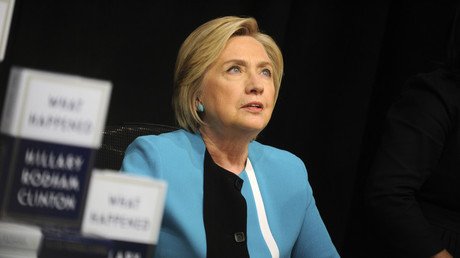‘Temples to colonial theft’: Western museums should return looted artifacts to where they belong
Is it possible to ‘loan’ something back to the person or place you stole it from? The British Museum in London, which houses one of the biggest permanent collections of world art and artifacts, certainly seems to think so.
Last week, responding to an emotional plea from the governor of Easter Island, the museum generously announced that it would consider “loaning” an 800-year-old statue back to the territory, which is now part of Chile.
The Hoa Hakananai’a was stolen — or “taken without permission” as The Guardian more delicately put it — in 1868 by the British HMS ‘Topaze’ and delivered to Queen Victoria. The museum itself uses even more sanitized language. Its online information page about the statue explains that it was “collected” during the frigate’s expedition to Rapa Nui (Easter Island) and was “gifted” by the Queen to the museum a year later.
“This statue would have originally stood on a specially built platform on the sacred site of Orongo,” the museum explains. “It would have stood with giant stone companions, their backs to the sea, keeping watch over the island.”
Also on rt.com Easter Island people want return of their sacred statue, stolen by imperial BritsThe reason it doesn’t still serve this purpose, is because the museum refuses to give it back. The 2.4-meter statue has no cultural or emotional significance to British people. To the Rapa Nui people, on the other hand, the Hoa Hakananai’a is extremely culturally and spiritually significant.
“We are just a body. You, the British people, have our soul,” Governor Tarita Alarcon Rapu said through tears during a visit to the museum last week. “You have kept him for 150 years. Just give us some months and we can have it there.”
The Hoa Hakananai’a is just one example of many when it comes to spoils of the British Empire which sit permanently in UK exhibitions. The museum has also refused to return the Rosetta Stone, something the head of Egypt’s new national museum recently called for, and the Parthenon Marbles. Greek Prime Minister Alexis Tsipras recently raised the issue with Theresa May, saying that their “natural place” is at the Parthenon. In 2013, India called for the return of the Koh-i-noor diamond, which was taken and given to Queen Victoria in 1850. David Cameron dismissed the notion, saying he did not believe in “returnism.”
Just this week, news reports said that the London museum would temporarily return some of the iconic ancient Benin bronze sculptures to Nigeria. There are more than a thousand of the bronzes sitting in museums across Europe, and successive Nigerian governments have sought their return for decades. France is set to give back 26 of the sculptures permanently, a decision made after a report commissioned by President Emmanuel Macron called for thousands of African artworks to be returned.
“I cannot accept that a large part of the cultural heritage of several African countries is in France,” Macron said last year in Burkina Faso. “There are historical explanations for this but there is no valid, lasting and unconditional justification.”
According to the French report, about 90 percent of Africa’s cultural heritage is situated outside of the continent. When the British Museum returns “some” of their 700 Benin bronzes, however, it will only be on loan.
Also on rt.com Not just the Elgin Marbles: Britain’s colonial legacy lives long in UK museumsIn a recent article for The Guardian, Tiffany Jenkins, the author of an entire book about why Western museums should refuse to return their stolen treasures, writes that when the first wave of Benin bronzes were created, Benin was an empire and the objects were crafted on the back of the slave trade. Maybe the descendants of the Benin king should apologize for slavery before they are approved as “morally worthy owners of the artefacts,” she writes, rather ironically.
Jenkins argues reductively that history is ugly and tussling over the rights and wrongs of the past is a pointless exercise. If Western countries start returning artifacts looted during the colonial era, she says, “there could be no end to competitive claim-making.”
Well, so be it.
It is not any British or European museum’s right to withhold plundered treasures while it decides who is “morally worthy” of possessing them. The very suggestion reeks of colonial arrogance. Ultimately, Jenkins writes, artifacts in Western museums “enlighten us about the world” and that is the job of our museums. How lovely; stolen cultural heritage enlightens us deserving Westerners, so of course, it has fulfilled its one, true purpose.
The fact that repatriating colonial loot is complicated and uncomfortable is no good reason to avoid facing reality and doing the bare minimum to atone for past sins. This is cultural property we are talking about. It belongs to the peoples and cultures where it originated — and to quote Macron, there is “no valid, lasting and unconditional justification” for refusing their return.
Of course, it is not only British or French museums that house looted art and cultural objects. There has been an ongoing dispute between Russia and Germany over artwork looted when the Red Army conquered Berlin in 1945. Much of the looted items were returned to East Germany after 1945, but not all of them. Moscow claimed the looting was a legitimate response to Germany’s invasion of the Soviet Union and its destruction of Soviet national treasures. Germany begged to differ.
In October, the British Museum launched an initiative to counter the perception that everything within its walls is looted treasure — but Twitter users quickly made fun of the effort. ‘We didn’t steal all of it’ is hardly a very persuasive or positive-sounding plea.
Also on rt.com Art decolonization: France to return 26 looted masterpieces claimed by BeninThat campaign came after art historian Alice Procter made headlines for giving ‘Uncomfortable Art Tours’ in British museums. The tours focus on slavery and colonialism and Porter encourages participants to wear ‘Display It Like You Stole It’ badges as they wander the exhibitions to advocate for more honest descriptions under artifacts. “On most text panels there’s little or no mention of how objects came to be there. Euphemistic language of ‘acquisition’ obscures the truth,” Procter wrote in a piece for The Guardian.
“You can look at the Gweagal shield in the British Museum and have no idea that it is considered crucial to the story of indigenous and settler relations in Australia, that its position in the museum is extremely controversial, and it’s sought by Gweagal people today,” she adds.
Another argument those against repatriation frequently use is that indigenous people, in some cases, offered or sold cultural objects to colonizers in exchange for something they needed more — money or tools, for example. Those items, they argue, can’t be said to be ‘stolen’ — but this completely ignores the power imbalance of the relationship between the colonizer and the colonized.
“Collected,”“acquired,” and “taken without permission” in this context are simply euphemisms for “stolen.” It is clear that museums and people like Jenkins are worried about setting a precedent. The British Museum is nothing short of a temple to colonial theft — and returning just one item would open the floodgates.
It will never happen, of course, but in an ideal world, that would be just one extremely tiny — and wholly inadequate — price to pay for hundreds of years of colonial massacre and plunder.
Like this story? Share it with a friend!
The statements, views and opinions expressed in this column are solely those of the author and do not necessarily represent those of RT.















